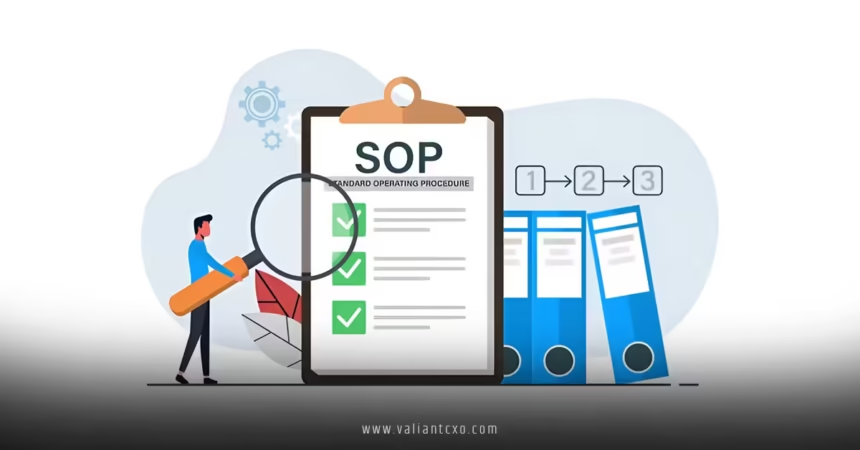How to write standard operating procedures US might sound like a daunting task, but it’s like building a roadmap for your team to follow. Whether you’re running a small business, managing a corporate department, or leading a nonprofit, standard operating procedures (SOPs) are the backbone of consistency and efficiency. They’re the “how-to” guides that keep everyone on the same page, ensuring tasks are done right every time. In the US, where industries range from tech startups to manufacturing giants, SOPs are critical for compliance, productivity, and scaling operations. Let’s dive into crafting SOPs that are clear, actionable, and tailored to your needs.
What Are Standard Operating Procedures and Why Do They Matter?
Imagine trying to bake a cake without a recipe. You’d probably end up with a lumpy mess. That’s what work can feel like without SOPs. Standard operating procedures are detailed, written instructions that outline how to perform specific tasks or processes in a business. They’re designed to standardize operations, reduce errors, and ensure compliance with US regulations, whether it’s OSHA safety standards or FDA guidelines.
Why are SOPs a big deal? They save time, reduce training costs, and minimize mistakes. In the US, where industries face strict regulatory oversight, SOPs also help you avoid costly penalties. Plus, they make your business scalable—new employees can hit the ground running with a clear guide. So, how do you write standard operating procedures US that actually work? Let’s break it down.
Step-by-Step Guide to Writing Standard Operating Procedures US
Creating SOPs isn’t just about slapping some instructions on paper. It’s about clarity, precision, and usability. Here’s a step-by-step process to help you craft SOPs that your team will actually use.
Step 1: Identify the Process and Its Purpose
Before you start writing, ask yourself: What process needs an SOP? Is it onboarding new hires, handling customer complaints, or maintaining equipment? Pinpoint the task and its goal. For example, if you’re writing an SOP for inventory management in a US warehouse, the purpose might be to ensure accurate stock levels and compliance with federal regulations.
Pro tip: Talk to the people who perform the task daily. Their insights will help you understand the process inside out. This is where the “experience” part of EEAT comes in—real-world input makes your SOPs practical and trustworthy.
Step 2: Choose the Right Format for Your SOP
Not all SOPs look the same. Depending on the task, you might choose one of these formats:
- Step-by-Step List: Perfect for simple processes, like how to process a return in a retail store.
- Hierarchical Steps: Ideal for complex tasks with sub-steps, like setting up a manufacturing line.
- Flowchart: Great for decision-based processes, like troubleshooting IT issues.
- Checklist: Handy for tasks that don’t need detailed instructions, like daily opening procedures.
When deciding how to write standard operating procedures US, pick a format that matches your team’s needs and the task’s complexity. A US-based restaurant might use a checklist for closing duties, while a pharmaceutical company might need a detailed hierarchical SOP for quality control.
Step 3: Gather All Necessary Information
Now, collect the details. What tools, materials, or software are needed? Who’s responsible for each step? Are there specific US regulations to follow, like EPA guidelines for hazardous materials? For example, if you’re writing an SOP for a construction site, include safety gear requirements to comply with OSHA standards.
Don’t just guess—consult experts, review compliance documents, and observe the process in action. This ensures your SOP is authoritative and aligns with the EEAT strategy.
Step 4: Write Clear and Concise Instructions
Here’s where the rubber meets the road. When writing your SOP, use simple language that anyone can understand. Avoid jargon unless it’s industry-standard and necessary. For instance, a medical SOP might include terms like “sterilization protocol,” but a retail SOP should stick to plain English like “clean the register.”
Structure each step like this:
- Action: What to do (e.g., “Scan the item’s barcode”).
- Details: Any specifics (e.g., “Use the handheld scanner model XYZ”).
- Outcome: What should happen (e.g., “The item appears on the POS screen”).
When figuring out how to write standard operating procedures US, clarity is king. Use active voice (“Enter the data” instead of “The data should be entered”) and keep sentences short. Think of your SOP as a friendly guide, not a legal document.
Step 5: Include Visuals and Examples
A picture is worth a thousand words, especially in SOPs. Add diagrams, flowcharts, or photos to clarify complex steps. For example, an SOP for assembling machinery might include labeled images of parts. If you’re writing an SOP for a US-based call center, include sample scripts for handling customer complaints.
Visuals make your SOPs user-friendly and boost engagement. They also show your expertise, reinforcing the EEAT principles.
Step 6: Address Compliance and Safety
In the US, compliance is non-negotiable. Whether it’s HIPAA for healthcare or DOT regulations for transportation, your SOPs must reflect legal requirements. For instance, an SOP for handling hazardous waste should detail EPA-compliant disposal methods. Include safety warnings, like “Wear gloves when handling chemicals,” to protect employees and avoid liability.
Not sure where to start? Check out resources like the Occupational Safety and Health Administration (OSHA) for workplace safety guidelines or the Food and Drug Administration (FDA) for food and drug regulations.
Step 7: Review and Test Your SOP
Before rolling out your SOP, test it. Have a team member follow the instructions exactly as written. If they get stuck, revise the steps. This trial run ensures your SOP is practical and effective. For example, if your SOP is for a US retail chain’s cash-handling process, test it during a busy shift to catch any gaps.
Ask for feedback from employees and supervisors. Their input will make your SOP more trustworthy and user-friendly, ticking the EEAT boxes.
Step 8: Implement and Train Your Team
Once your SOP is polished, it’s time to put it into action. Train your team on how to use it. For a US-based logistics company, this might mean walking drivers through a new delivery protocol. Use hands-on demos, Q&A sessions, or even videos to make training engaging.
Make sure your SOPs are accessible—store them in a shared drive or a platform like Trello for easy reference. Regularly update them to reflect new regulations or process changes.
Common Mistakes to Avoid When Writing SOPs
Even the best intentions can go awry. Here are some pitfalls to watch out for when learning how to write standard operating procedures US:
- Overcomplicating Instructions: Don’t write a novel. Keep steps short and to the point.
- Ignoring Employee Input: Your team knows the process best. Involve them early.
- Skipping Updates: Regulations and processes change. Review SOPs annually to stay compliant.
- Being Too Vague: “Do it carefully” doesn’t cut it. Specify what “carefully” means.
Avoiding these mistakes ensures your SOPs are practical, compliant, and easy to follow.
Tips for Making Your SOPs User-Friendly
Want your SOPs to be loved, not loathed? Here are some tips to make them shine:
- Use a Consistent Template: A uniform format makes SOPs easier to navigate.
- Add a Table of Contents: For long SOPs, this helps users find what they need.
- Include a Glossary: Define technical terms for newbies.
- Make It Digital: Use PDFs or cloud storage for easy access and updates.
When thinking about how to write standard operating procedures US, user-friendliness is key to ensuring adoption and success.
How to Write Standard Operating Procedures US for Different Industries
SOPs vary by industry. Here’s how to tailor them for specific US sectors:
Healthcare
In healthcare, SOPs must comply with HIPAA and CDC guidelines. For example, an SOP for patient check-ins might include steps for verifying insurance and protecting patient privacy. Use precise language and include checklists for infection control.
Manufacturing
Manufacturing SOPs focus on safety and efficiency. An SOP for operating heavy machinery should detail safety checks, startup procedures, and shutdown protocols, aligning with OSHA standards.
Retail
Retail SOPs prioritize customer experience and consistency. An SOP for handling returns might include steps for processing refunds and updating inventory, ensuring compliance with consumer protection laws.
Tech
In tech, SOPs often cover software processes. For instance, an SOP for deploying code might include steps for testing and version control, ensuring smooth operations in fast-paced environments.
No matter the industry, how to write standard operating procedures US starts with understanding your audience and their needs.
Conclusion
Mastering how to write standard operating procedures US is like giving your business a GPS for success. By following a clear process—identifying tasks, choosing the right format, writing concise instructions, and testing thoroughly—you can create SOPs that boost efficiency, ensure compliance, and empower your team. Avoid common pitfalls, involve your employees, and keep your SOPs user-friendly. Whether you’re in healthcare, retail, or tech, well-crafted SOPs are your ticket to smoother operations and fewer headaches. So, grab a pen (or keyboard) and start building those procedures today—your future self will thank you!
FAQs
1. Why is it important to learn how to write standard operating procedures US?
Learning how to write standard operating procedures US ensures your business complies with regulations, reduces errors, and improves efficiency. SOPs create consistency, making it easier to train employees and scale operations.
2. How often should I update my SOPs?
Review SOPs annually or whenever processes or US regulations change. Regular updates keep your procedures relevant and compliant.
3. Can I use templates for writing SOPs?
Yes, templates are a great starting point for how to write standard operating procedures US. Customize them to fit your industry and specific tasks for best results.
4. How do I make SOPs easy to understand?
Use simple language, visuals, and a clear structure. Avoid jargon and test your SOPs with team members to ensure clarity.
5. What’s the biggest mistake when writing SOPs?
One major mistake is not involving employees who perform the task. Their insights are critical for creating practical and effective SOPs.
For More Updates !! : valiantcxo.com


